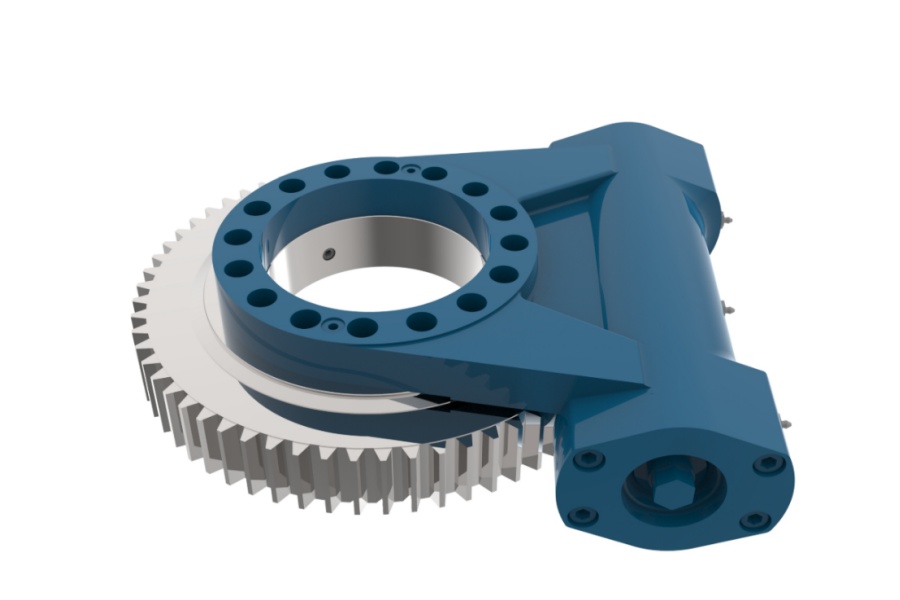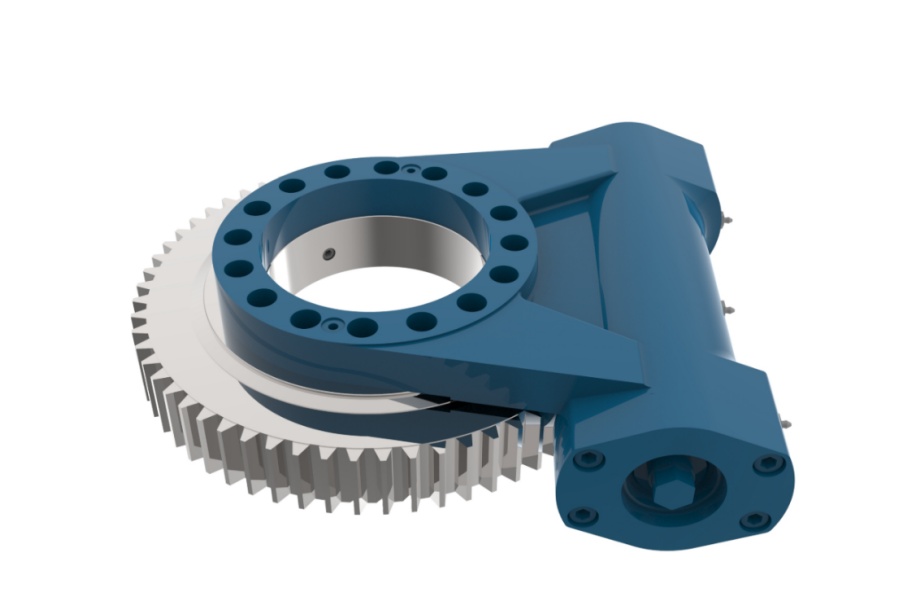
Причины и решения утечки масла из поворотного привода
Что такое поворотный привод?
Аповоротный приводЭто высокоинтегрированный компонент механической передачи мощности, объединяющий поворотный подшипник, червячный редуктор, корпус и уплотнительные элементы в единый компактный узел. Его основная функция — обеспечить контролируемое вращательное движение вокруг одной оси с одновременной поддержкой значительных комбинированных нагрузок, включая осевые, радиальные и моментные. В основе его работы лежит червячный механизм, в котором червячный винт входит в зацепление с зубчатым венцом, установленным на внутреннем или наружном кольце подшипника. При вращении червяка внешним двигателем (электрическим или гидравлическим) он приводит в движение шестерню, приводя во вращение всю конструкцию подшипника. Такая конфигурация обеспечивает высокое передаточное отношение на одной ступени, преобразуя высокоскоростной входной крутящий момент с низким крутящим моментом в низкоскоростной выходной крутящий момент с высоким крутящим моментом. Это делает его исключительно мощным для своего размера. Важным неотъемлемым преимуществом многих конструкций поворотных приводов является их способность к самоблокировке, которая предотвращает обратный ход и надежно удерживает груз без внешнего тормоза. Поворотные приводы ценятся за их способность упрощать проектирование и установку для производителей оригинального оборудования в различных отраслях тяжелой промышленности, предоставляя предварительно собранное, испытанное и надежное решение для вращательного движения.

Причины и решения утечки масла из поворотного привода
Утечки масла в поворотном приводе представляют собой серьёзную проблему, которая может привести к недостаточной смазке, ускоренному износу, выходу из строя компонентов и, в конечном итоге, к катастрофическому отказу системы. Своевременное устранение утечек и понимание их основных причин критически важны для поддержания эксплуатационной надёжности. Наиболее распространённой причиной утечек является повреждение уплотнений. Уплотнения могут со временем разрушаться под воздействием экстремальных температур, ультрафиолетового излучения, озона и агрессивных химических веществ, что приводит к их затвердеванию, растрескиванию или хрупкости. Также распространены механические повреждения уплотнений, часто возникающие из-за неправильной установки, использования острых инструментов или ударов посторонних предметов во время эксплуатации. Неправильный выбор уплотнения для конкретного применения (например, использование стандартного нитрилового уплотнения в условиях высоких температур или высокой химической нагрузки) также приведёт к преждевременному выходу из строя. Решение заключается в тщательном осмотре и замене повреждённых уплотнений. Всегда используйте материал уплотнений, указанный производителем (например, Viton/FKM для работы в условиях высоких температур или химических веществ), и обеспечивайте правильную установку, не допуская перекручивания или задира кромки уплотнения. Другим важным фактором является правильный подход к смазке. Избыточная смазка — распространённая ошибка. Подача слишком большого количества смазки в узел создаёт избыточное внутреннее давление, которое может продавливать уплотнения, выбрасывая их изнутри. Правильная процедура — всегда снимать пробку для выпуска смазки (вентиляционную пробку) во время смазки, чтобы дать старой смазке выйти и предотвратить повышение давления. Недостаточная смазка, с другой стороны, приводит к повышенному трению и нагреву, что со временем может привести к разрушению как смазки, так и уплотнений. Точно соблюдайте рекомендуемый производителем график и количество смазки.
Физические повреждения корпуса поворотного привода могут привести к утечкам. К ним относятся трещины или пористость в отливке корпуса, возникающие из-за производственного дефекта, или, что более распространено, повреждения от удара или чрезмерной нагрузки. Поврежденная уплотнительная поверхность, например, царапины или выбоины в месте установки уплотнения, препятствуют надлежащему уплотнению. Устранение повреждений корпуса может быть сложным. Незначительные царапины на уплотнительных поверхностях иногда можно отполировать, но значительные трещины или повреждения обычно требуют замены всего корпуса или узла. Правильное обращение при установке и эксплуатации является ключом к предотвращению утечек. Износ подшипников и внутренние зазоры также могут привести к утечкам. Со временем нормальный износ или ненадлежащая нагрузка могут привести к увеличению внутренних зазоров между червяком и шестерней или внутри дорожек подшипников. Это может привести к чрезмерному перемещению или прогибу под нагрузкой, что может поставить под угрозу способность уплотнения сохранять статическое уплотнение. При подозрении на внутренний износ необходим тщательный осмотр квалифицированным специалистом. Узел может потребовать капитального ремонта или замены. Наконец, использование неподходящего типа смазки может вызвать проблемы. Некоторые смазки несовместимы с определенными материалами уплотнений. Несовместимые смазки могут вызвать разбухание, усадку или ускоренную химическую деградацию уплотнений, что приводит к утечкам. Всегда используйте смазку того типа и вязкости, которые указаны производителем поворотного привода, чтобы обеспечить совместимость со всеми внутренними компонентами, включая уплотнения.
Характеристики поворотных приводов
Поворотные приводы характеризуются уникальным набором технических характеристик, делающих их предпочтительным решением для тяжёлых вращательных применений. Их важнейшей особенностью является исключительная грузоподъёмность. Единый компактный блок разработан для одновременного воздействия сложной комбинации осевых нагрузок (параллельных оси вращения), радиальных нагрузок (перпендикулярных оси) и опрокидывающих моментов (сил наклона). Эта многофункциональность устраняет необходимость в дополнительных опорных конструкциях, изготавливаемых по индивидуальному заказу, упрощая конструкцию и экономя пространство. Интегрированный червячный механизм обеспечивает очень высокое передаточное отношение на одной ступени, что обеспечивает исключительно высокий выходной крутящий момент. Это позволяет использовать более компактные и экономичные двигатели, сохраняя при этом высокую крутящую силу, необходимую для перемещения массивных грузов.
Важнейшей характеристикой конструкции червячной передачи является её способность к самоторможению. В червячных передачах с малым углом опережения зажигания трение внутри зубчатой передачи предотвращает обратное движение выходного вала относительно входного. Эта функция действует как встроенный тормоз, надёжно удерживая грузы на месте без необходимости использования внешней тормозной системы, что крайне важно для безопасности в таких областях применения, как краны и лифты. Кроме того, поворотные приводы обеспечивают превосходную точность и управляемость. Редуктор обеспечивает плавное и точное позиционирование, что крайне важно в таких областях применения, как слежение за солнцем, юстировка радиолокационных антенн и робототехника. Ещё одной ключевой особенностью является их интегрированная и модульная конструкция. Объединяя подшипник, редуктор, уплотнения, а зачастую и опоры двигателя в один предварительно собранный и испытанный узел, поворотные приводы значительно снижают сложность проектирования и время сборки для производителей оригинального оборудования. Эта интеграция также повышает общую структурную жёсткость и крутильную жёсткость системы, минимизируя прогиб под нагрузкой и обеспечивая точное и повторяемое движение. Наконец, современные поворотные приводы рассчитаны на долговечность и надежность. Они используют высококачественные закалённые материалы шестерён, передовые системы герметизации для предотвращения попадания загрязнений и рассчитаны либо на смазку на весь срок службы, либо на лёгкий доступ для обслуживания, что гарантирует надёжность в самых сложных условиях.
Применение поворотных приводов
Надежность и универсальность поворотных приводов привели к их широкому применению в самых разных отраслях, где требуется контролируемое вращение под большой нагрузкой. Доминирующее и растущее применение – в секторе возобновляемой энергетики. В солнечной энергетике поворотные приводы являются основным исполнительным механизмом в системах слежения за солнцем. Они точно и медленно вращают массивные массивы фотоэлектрических панелей, следуя за траекторией движения солнца по небу, увеличивая улавливание энергии до 25-30% по сравнению со стационарными системами. Их способность к самоблокировке критически важна для предотвращения смещения панелей под действием ветровых нагрузок. Аналогичным образом, в ветроэнергетике поворотные приводы являются важнейшими компонентами систем рыскания и тангажа ветряных турбин. Система рыскания использует несколько больших поворотных приводов для поворота всей гондолы, чтобы лопасти ротора были направлены прямо навстречу ветру. Системы управления шагом, расположенные в ступице ротора, используют меньшие поворотные приводы для индивидуальной регулировки угла каждой лопасти для оптимизации выработки электроэнергии и управления структурными нагрузками при сильном ветре.
Строительная промышленность и тяжелое машиностроение являются еще одним крупным сектором, зависящим от поворотных приводов. Они обеспечивают вращение на 360 градусов для верхних частей экскаваторов, поворотное движение стрел мобильных кранов и точное позиционирование стрел бетононасосов и платформ доступа. Их компактная конструкция и высокая грузоподъемность делают их идеальными для мобильной техники с ограниченным пространством. Другие важные области применения включают робототехнику и промышленную автоматизацию, где они обеспечивают сверхпрочные оси вращения для сварочных роботов, паллетизаторов и сборочных машин, требующих точного позиционирования. Аэрокосмический и оборонный секторы используют их в системах позиционирования антенн радаров и спутниковой связи, где они должны обеспечивать непоколебимую точность и надежность в жестких условиях. Они также встречаются на палубных кранах и лебедках на кораблях и судах, в медицинском оборудовании визуализации, таком как сканеры КТ и МРТ для позиционирования пациентов, а также в индустрии развлечений для вращающихся сцен и тяжелых осветительных установок.
Факторы, влияющие на цену поворотного привода
Стоимость поворотного привода сильно варьируется и определяется сложным взаимодействием технических характеристик, эксплуатационных требований и коммерческих факторов. Наиболее важным фактором, влияющим на стоимость, являются физические размеры и грузоподъемность устройства. Более крупные приводы с увеличенным диаметром подшипников и зубчатыми модулями требуют значительно большего расхода сырья и более интенсивной механической и термической обработки, что делает привод, рассчитанный на нагрузку 100 тонн, значительно дороже привода для легких условий эксплуатации. Требуемые показатели точности и производительности также напрямую влияют на цену. Устройство, разработанное для сверхточной работы с практически нулевым люфтом в спутниковой антенне, требует более жестких производственных допусков, использования более качественных компонентов (например, керамических шариков) и более тщательного контроля качества, чем привод для строительного экскаватора.
Выбор материалов и характеристик защиты от коррозии в значительной степени определяет конечную стоимость. Стандартный привод из углеродистой стали с простым лакокрасочным покрытием является наиболее экономичным вариантом. Однако использование расширенной защиты, такой как горячее цинкование, фирменное покрытие Geomet® или изготовление всего привода из нержавеющей стали (например, марки 316), существенно увеличивает стоимость. Интегрированные функции и уровень настройки являются весьма изменчивыми факторами стоимости. Стандартный, готовый привод обходится дешевле всего. Индивидуальные настройки, такие как специальные монтажные фланцы, встроенные высокоточные энкодеры для обратной связи по положению, специальные крепления двигателя или специальные уплотнения для обеспечения химической стойкости, требуют дополнительных инженерных и производственных усилий, что повышает цену. Объём заказа играет решающую роль благодаря эффекту масштаба. Крупносерийный заказ для OEM-проекта позволяет производителю амортизировать фиксированные затраты (например, на оснастку и настройку) на несколько приводов, что значительно снижает стоимость каждого привода. И наоборот, разовая закупка для замены или создания прототипа будет сравнительно дорогой. Наконец, динамика внешнего рынка, включая колебания стоимости сырья (например, цен на сталь) и условий глобальной цепочки поставок, может оказывать влияние на базовую цену комплектующих и готовой продукции.
Поставщик поворотных приводов
Для инженеров и специалистов по закупкам, ищущих надежный источник высокопроизводительных поворотных приводов,ЛИРАДРАЙВКомпания LYRADRIVE является надежным производителем и поставщиком решений. Компания заслужила прочную репутацию благодаря инженерному совершенству, точности производства и приверженности долговечности и надежности своей продукции. LYRADRIVE предлагает обширный портфель стандартных и полностью индивидуальных решений в области поворотных приводов, разработанных для удовлетворения жестких требований различных отраслей, включая возобновляемую энергетику, строительство, обработку материалов и промышленную автоматизацию. Ключевым преимуществом LYRADRIVE является совместный подход, основанный на тесном сотрудничестве с клиентами для разработки приводных систем, идеально интегрируемых в конкретные области применения, оптимизируя их под нагрузку, скорость, условия окружающей среды и пространственные ограничения. Команда технической поддержки компании предоставляет экспертные консультации от этапа разработки концепции до установки и обслуживания, обеспечивая оптимальную производительность и долговечность. Кроме того, LYRADRIVE уделяет особое внимание строгому контролю качества, использованию высококачественных материалов и передовых технологий производства, чтобы гарантировать исключительную надежность каждого устройства в эксплуатации.



